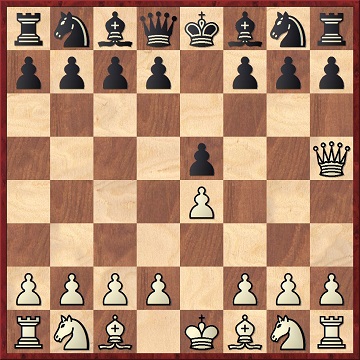
Edward Winter

Readers of Chess Characters, Reminiscences of a Badmaster (Geneva, 1984) will recall G.H. Diggle’s comments on changing opening fashions. From article 69, a description of ‘London Open Air Chess’:
‘... the BM noticed a “tender infant” of some three feet high opening in a skittle with 1 P-KN3 and 2 B-N2; how he sighed for his own robust days of schoolboy chess when 1 P-K4 and 2 Q-R5 was “book”, followed by the “thematic” 2...P-KN3, 3 QxKPch, 4 QxR and Q x everything else she could lay her hands on.’
The only 2 Qh5 game we can recall seeing in print is E.E. Southard v H.B. Hill (in a Boston v New England match), which appeared on pages 112-113 of the January 1907 issue of the Chess Amateur. White won in 27 moves. The annotator, W.P. Turnbull, writes of 2 Qh5: “The Danvers Opening. Not so bad as it looks.” After 2...Nc6 3 Bc4 Qf6 he says that 3...Qe7 may be better, reserving f6 for the knight, or 3...g6. The game continued 4 Nc3 Bc5 5 Nf3. Turnbull asks whether White could have played 5 Nd5, giving as a possible sequel 5...Qxf2+ 6 Kd1 Qxg2 7 Nxc7+ Kd8 8 Nxa8 Bxg1.
Where does ‘Danvers’ come from?
(1382)
Richard Lappin (Jamaica Plain, MD, USA) informs us that he recently gained access to Daly’s archives, which are currently located at the Boylston Chess Club, Boston, MA. He has discovered two 1 e4 e5 2 Qh5 games, which Daly headed with ‘Danvers Opening’. These begin as follows:
1) H.B. Daly v G.N. Cheney, ‘N.Y.S.C.A. General Tournament, Trenton Falls, NY, 24 July 1906’: 1 e4 e5 2 Qh5 Nc6 3 Bc4 Qe7 4 d3 Nf6 5 Qf3 Nd4 6 Qd1 b5 7 Bb3 Nxb3 8 axb3 Qe6 9 f4 Bc5 10 f5 Qc6. (Black resigned at move 39.)
2) H.B. Daly v J.L. McCudden, ‘N.Y.S.C.A. Championship Tournament, Rye Beach, NY, Round 3, 24 July 1918’: 1 e4 e5 2 Qh5 Nf6 3 Qxe5+ Be7 4 Nc3 Nc6 5 Qg3 Nb4 6 Kd1 d5 7 a3 d4 8 axb4 dxc3 9 bxc3 Nxe4 10 Qe3 Nf6. (Black resigned at move 45.) [For the full game, see C.N. 9597.]
From Gaige’s Chess Personalia: Harlow Bussey Daly, born in Dorchester, MA on 2 December 1883, died on 8 July 1979 in Framingham, MA. The Massachusetts connection may be relevant, since Danvers is a town in that state.
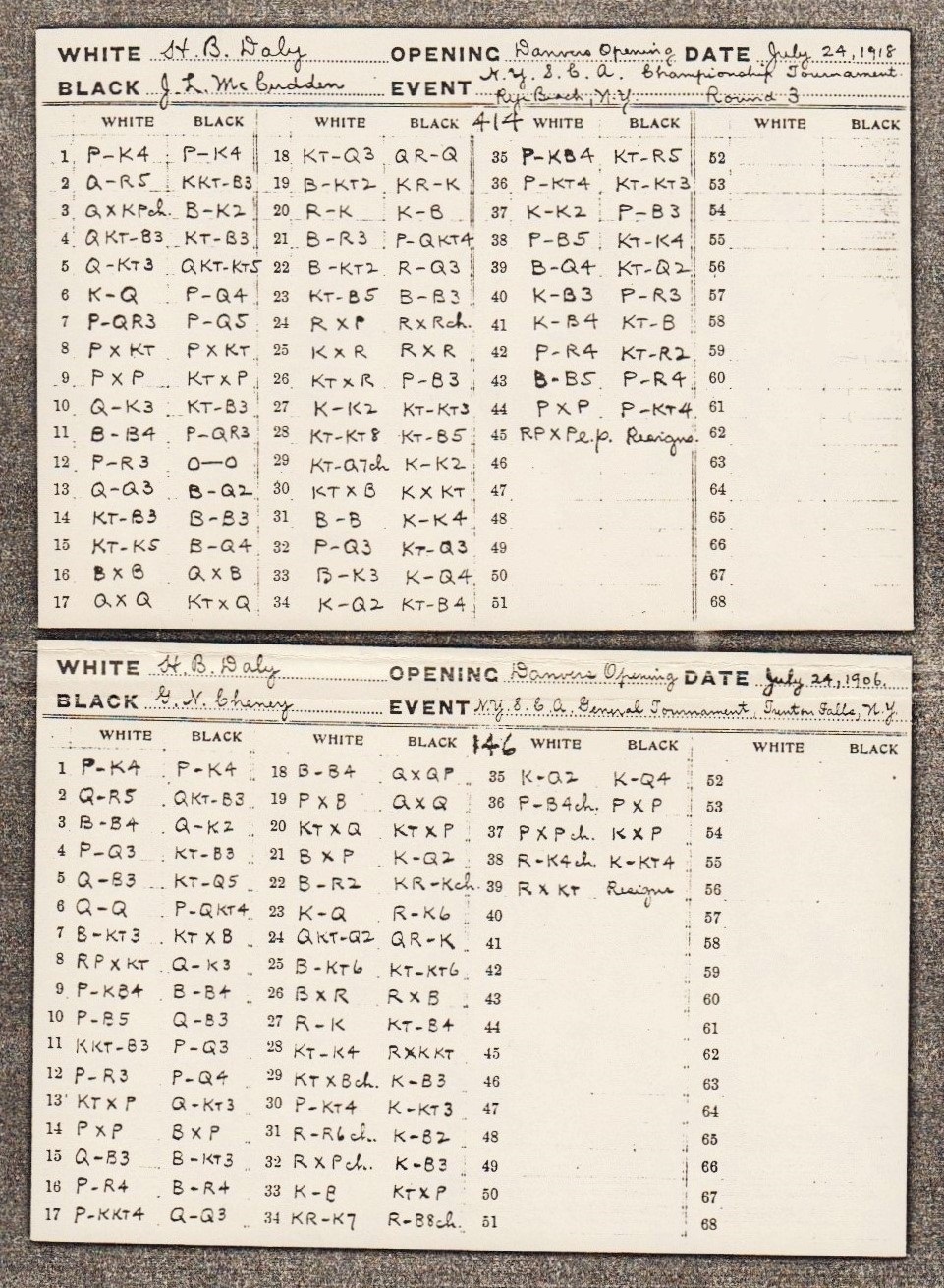
(1535)
Found at last: the origin of the name ‘Danvers Opening’ (1 e4 e5 2 Qh5).
From page 1 of the January 1908 American Chess Bulletin (an account of speeches at a banquet marking the 50th birthday of the Boston Chess Club):
‘Dr E.E. Southard, who was the Harvard College champion for a number of years and who is now a specialist on mental diseases at the Danvers Insane Hospital, tried to explain how his acquaintance with chessplayers assisted him in his profession and why he named his pet début the Danvers Opening, which consists of P-K4 and Q-R5 as White’s first and second moves.’
It is easy to imagine the above finding its way into many a future chess trivia quiz (‘What opening was named after an institution for the insane?’).
The Southard v Hill game referred to in C.N. 1382 was played at Boston on 30 May 1905, and in the same (40-board) match a game between G.T. McClure and F. Mathewson opened 1 e4 e5 2 Qh5 Nf6 3 Qxe5+ Be7 4 Nc3 Nc6 5 Qf4 O-O 6 Be2 Bd6 7 Qe3 Re8 8 d3 Be5. Black resigned at move 42. Source: American Chess Bulletin, July 1905, pages 253, 254 and 258.
(1732)
Information about E.E. Southard was given in C.N.s 6350, 6351 and 6375. The first of these included the frontispiece of the US publication Elmer Ernest Southard and His Parents by Myrtelle M. Canavan (Cambridge, 1925):
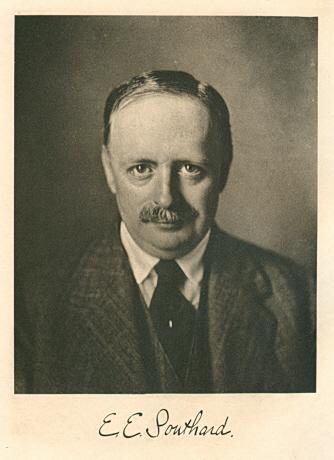
C.N. 6351 gave his obituary from page 46 of the March 1920 American Chess Bulletin:

An article entitled ‘Ein Gambit gegen 1 e4 e5 Dh5!?’ by Maurits Wind was published on pages 44-47 of Kaissiber, issue 30 (January-March 2008).
C.N. 3196 (see A Chess Database) mentioned the moves 1 e4 e5 2 Qh5 Nc6 3 Qxf7+, and there are many versions of the related story involving Emanuel Lasker. One ‘is-said-to’ example comes from page 90 of A History of Chess by Jerzy Giżycki (London, 1972):
‘Lasker is said to have won a game of “Alcoholic Chess” by sacrificing his queen in ridiculous fashion at the very outset of the game. The queen contained about a quarter litre of cognac; quaffing this seriously incapacitated his opponent in the ensuing complications – B.H. Wood.’
Page 283 of the August 1959 CHESS had an account reproduced from a chess programme on BBC radio:
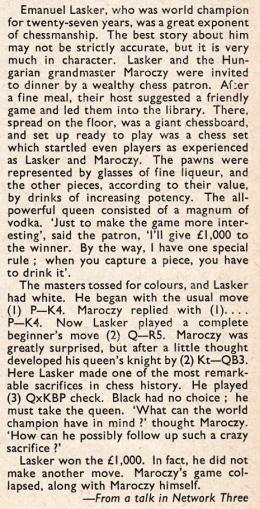
How far back can the story be traced? We recall an editorial account of a lunch with G. Koltanowski, one of the least reliable of all chess chroniclers, on page 255 of the November 1938 Chess Review:
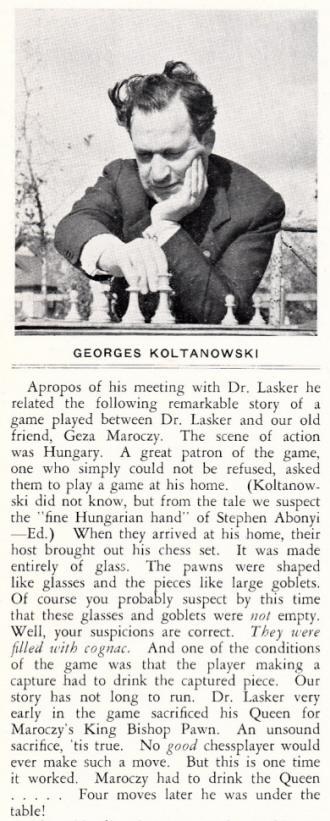
To the Chess Notes main page.
To the Archives for other feature articles.
Copyright: Edward Winter. All rights reserved.